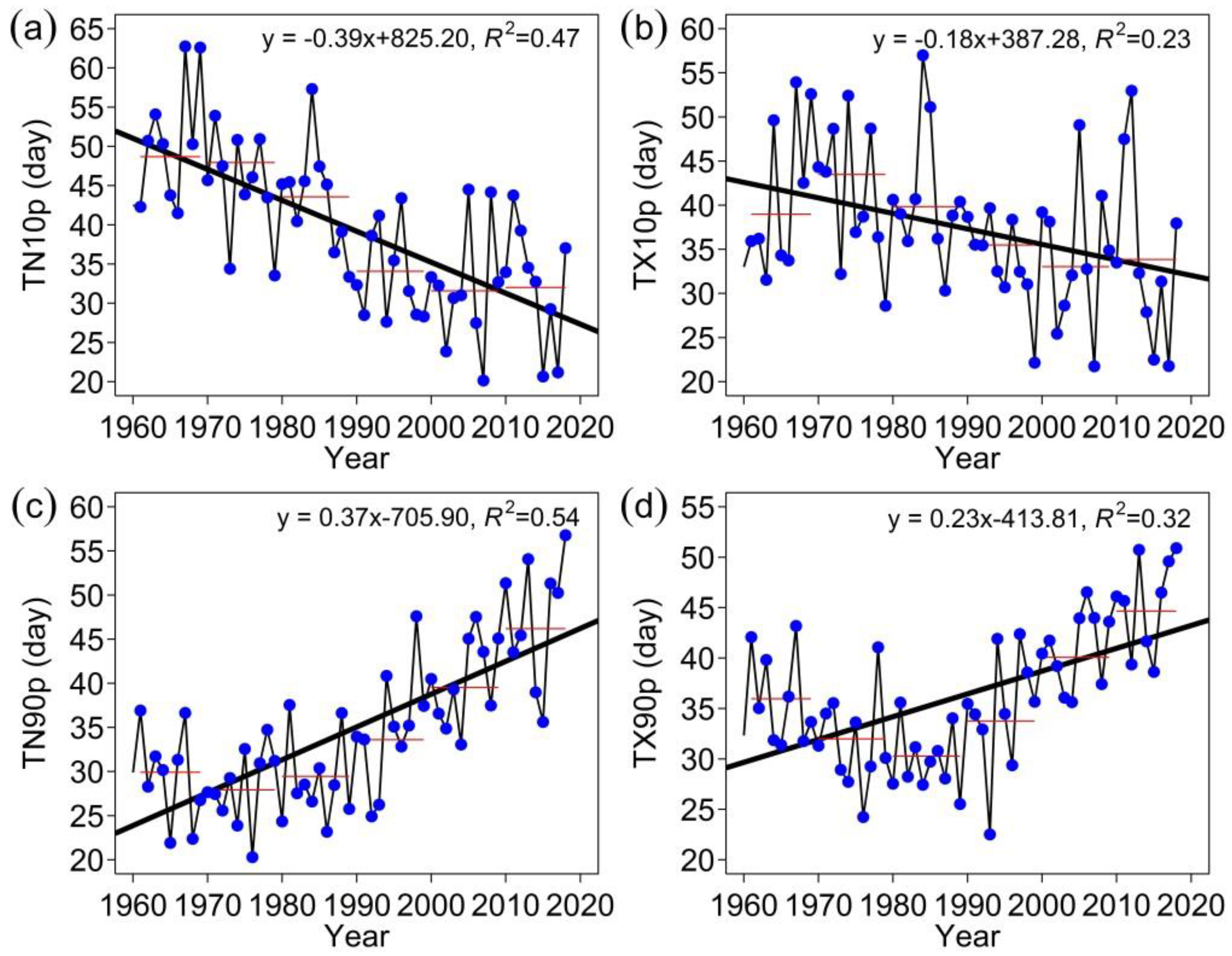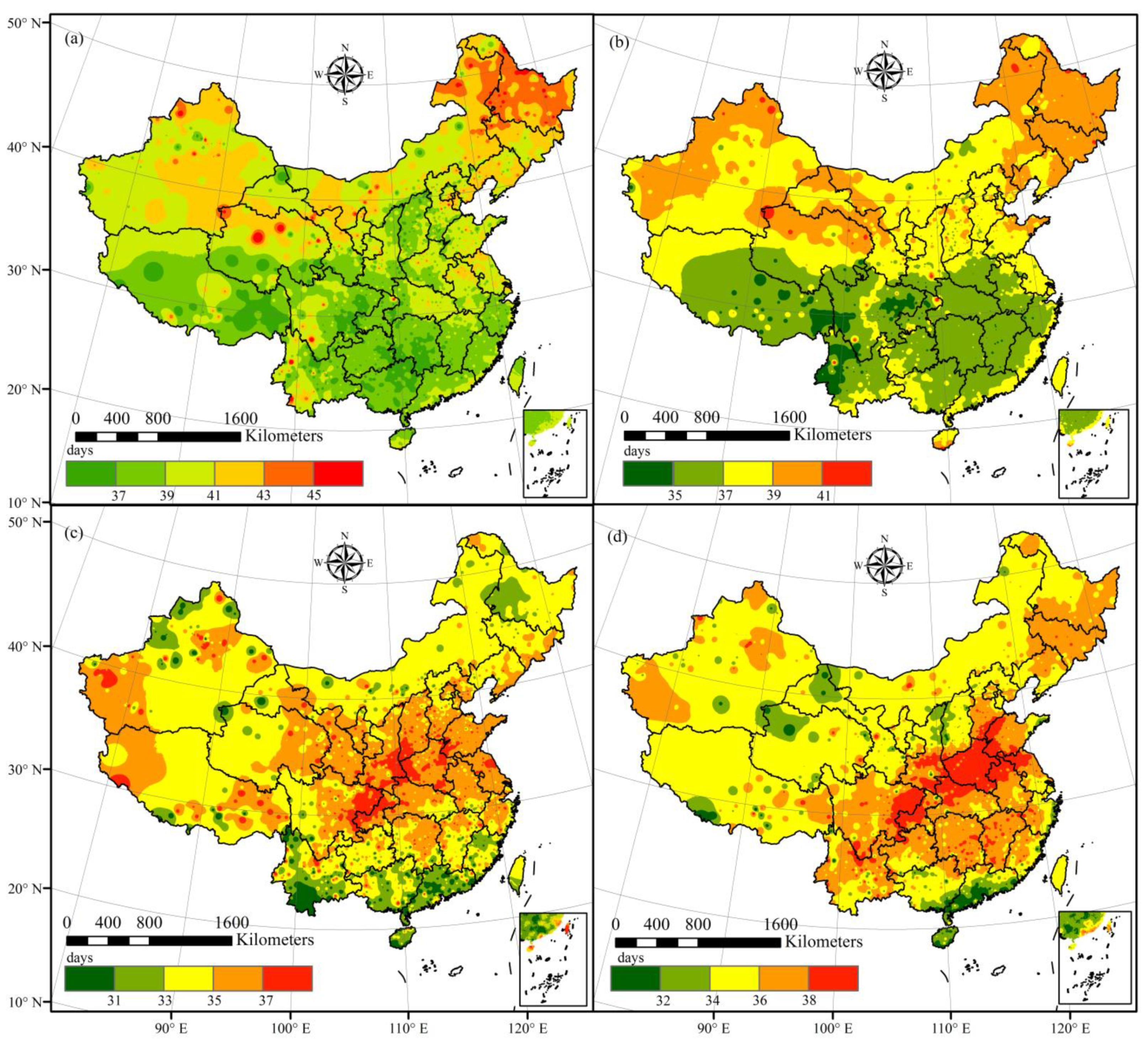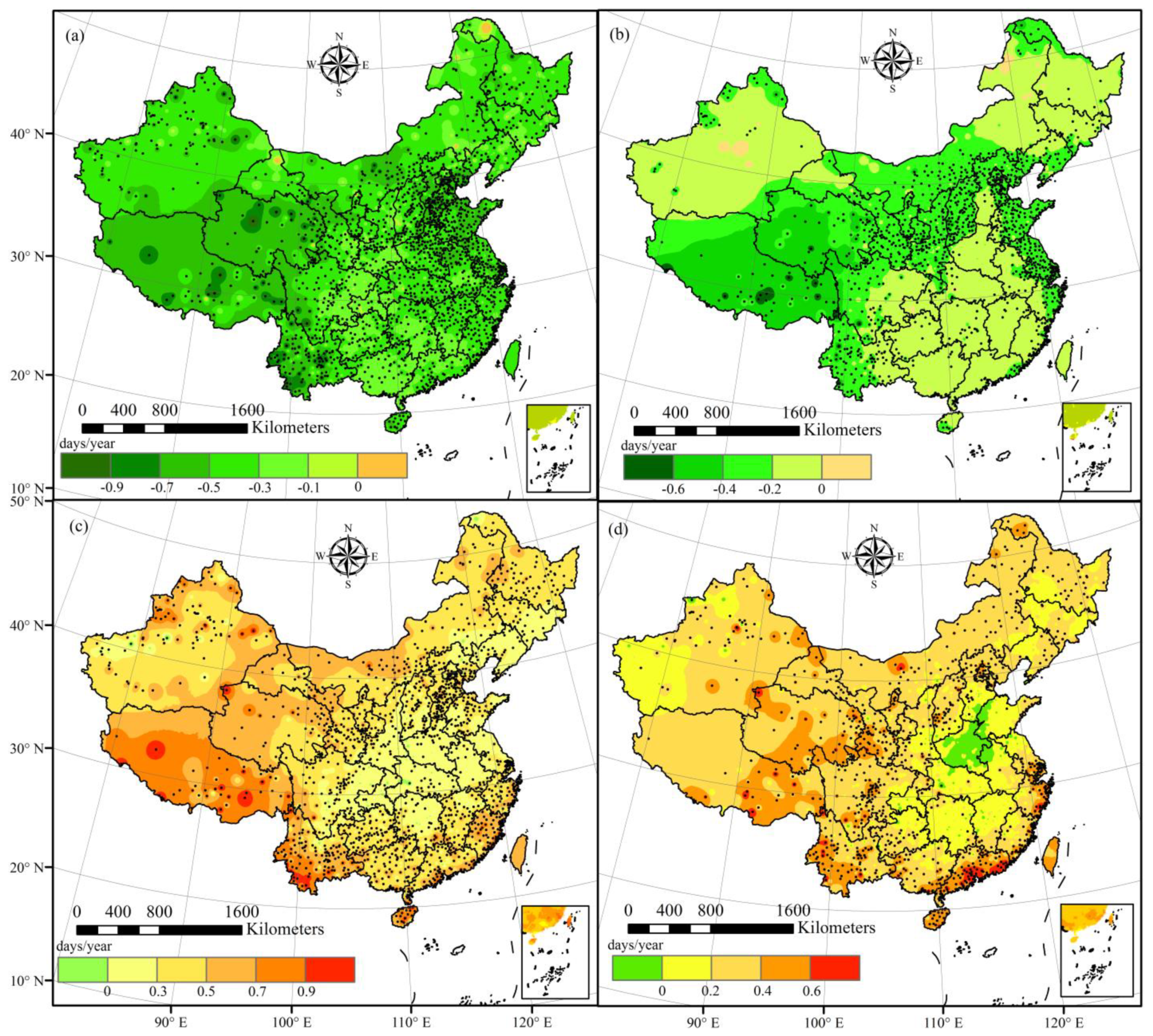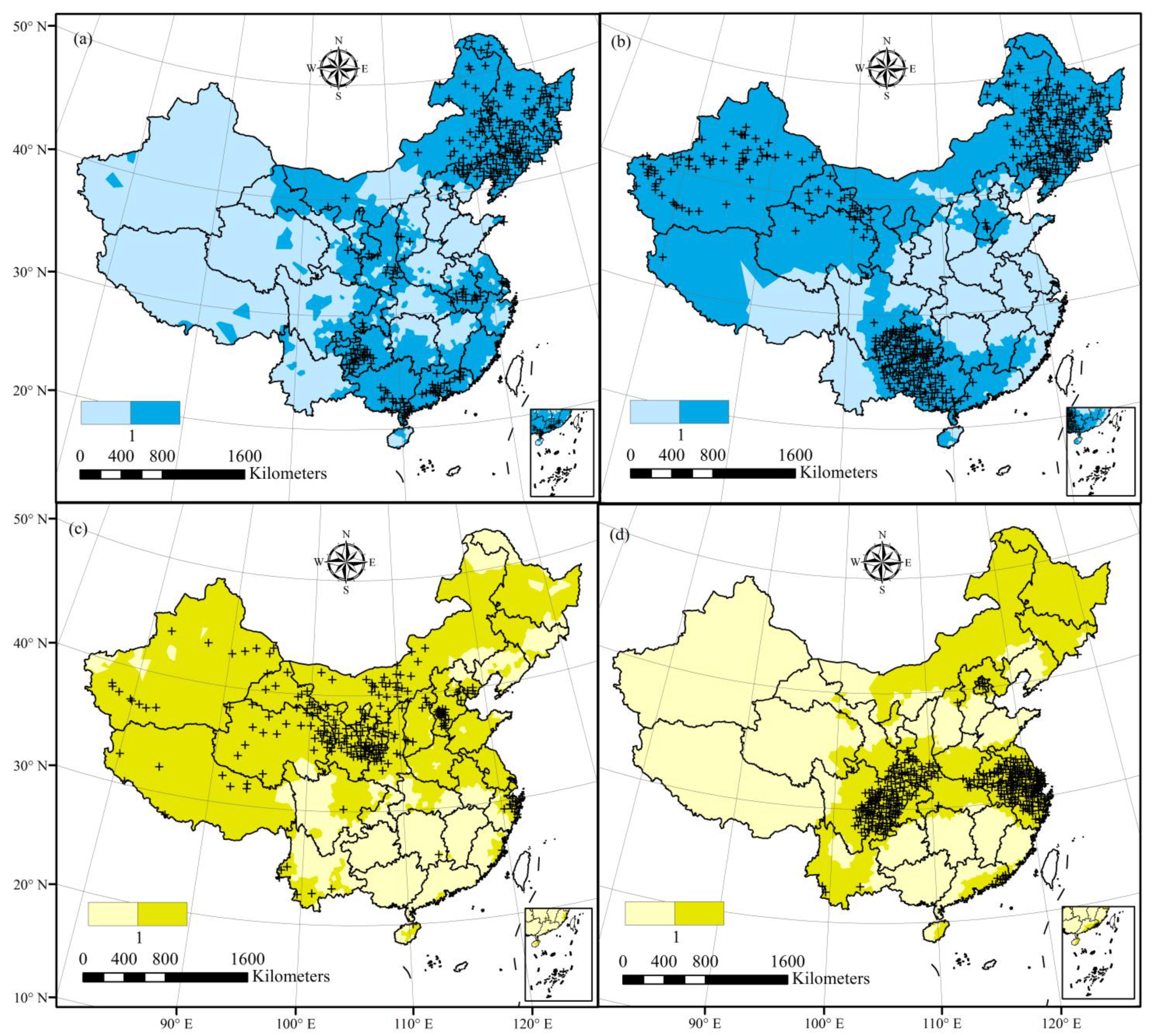A Comprehensive Study of Spatiotemporal Variations in Temperature Extremes across China during 1960–2018
Abstract
:1. Introduction
2. Data and Methods
2.1. Data
2.2. Methods
3. Results
4. Discussion
5. Conclusions
Author Contributions
Funding
Institutional Review Board Statement
Informed Consent Statement
Data Availability Statement
Conflicts of Interest
References
- IPCC. Climate Change 2013: The Physical Science Basis. Contribution of Working Group I to the Fifth Assessment Report of the Intergovernmental Panel on Climate Change; Cambridge University Press: Cambridge, UK, 2013. [Google Scholar]
- Alexander, L.V.; Zhang, X.; Peterson, T.C.; Caesar, J.; Gleason, B.; Klein Tank, A.M.G.; Haylock, M.; Collins, D.; Trewin, B.; Rahimzadeh, F.; et al. Global observed changes in daily climate extremes of temperature and precipitation. J. Geophys. Res. 2006, 111, D05109. [Google Scholar] [CrossRef] [Green Version]
- Mazdiyasni, O.; AghaKouchak, A. Substantial increase in concurrent droughts and heatwaves in the United States. Proc. Natl. Acad. Sci. USA 2015, 112, 11484–11489. [Google Scholar] [CrossRef] [PubMed] [Green Version]
- Chen, W.; Dong, B.W.; Wilcox, L.; Luo, F.F. Attribution of recent trends temperature extremes over China: Role of changes in anthropogenic aerosol emissions over Asia. J. Clim. 2019, 32, 7539–7560. [Google Scholar] [CrossRef]
- Piao, S.; Ciais, P.; Huang, Y.; Shen, Z.H.; Peng, S.S.; Li, J.S.; Zhou, L.P.; Liu, H.Y.; Ma, Y.C.; Ding, Y.H.; et al. The impacts of climate change on water resources and agriculture in China. Nature 2010, 467, 43–51. [Google Scholar] [CrossRef]
- Curtis, S.; Fair, A.; Wistow, J.; Val, D.V.; Oven, K. Impact of extreme weather events and climate change for health and social care systems. Environ. Health 2017, 16, 23–32. [Google Scholar] [CrossRef] [Green Version]
- Zhang, Y.; Yang, P.L.; Gao, Y.; Leung, R.L.; Bell, M.L. Health and economic impacts of air pollution induced by weather extremes over the continental U.S. Environ. Int. 2020, 143, 105921. [Google Scholar] [CrossRef] [PubMed]
- United Nations Office for Disaster Risk Reduction (UNISDR). The Human Cost of Weather-Related Disasters, 1995–2015; UNISDR: Geneva, Switzerland, 2015; p. 27. [Google Scholar]
- IPCC. Summary for Policymakers Global Warming of 1.5 °C. An IPCC Special Report on the Impacts of Global Warming of 1.5 °C above Pre-industrial Levels and Related Global Greenhouse Gas Emission Pathways, in the Context of Strengthening the Global Response to the Threat of Climate Change, Sustainable Development, and Efforts to Eradicate Poverty; Masson-Demotte, V., Zhai, P., Portner, H.O., Roberts, D., Skea, J., Shukla, P.R., Pirani, A., Moufouma-Okia, W., Pean, C., Pidcock, R., et al., Eds.; World Meteorological Organization: Geneva, Switzerland, 2018. [Google Scholar]
- Yan, Z.; Jones, P.D.; Davies, T.D.; Moberg, A.; Bergstorm, H.; Camuffo, D.; Cocheo, C.; Maugeri, M.; Demaree, G.R.; Verhoeve, T.; et al. Trends of extreme temperatures in Europe and China based on daily observations. Clim. Chang. 2002, 53, 355–392. [Google Scholar] [CrossRef]
- Klein, T.A.; Peterson, T.C.; Quadir, D.A.; Dorji, S.; Zou, X.; Tang, H.; Santhosh, K.; Joshi, U.R. Changes in daily temperature and precipitation extremes in central and South Asia. J. Geophys. Res. Atmos. 2006, 111, D16105. [Google Scholar] [CrossRef]
- Coumou, D.; Rahmstorf, S. A decade of weather extremes. Nat. Clim. Chang. 2012, 2, 491–496. [Google Scholar] [CrossRef]
- Wang, B.; Liu, D.L.; Macadam, I.; Alexander, L.V.; Abramowitz, G.; Yu, Q. Multi-model ensemble projections of future extreme temperature change using a statistical downscaling method in south eastern Australia. Clim. Chang. 2016, 138, 85–98. [Google Scholar] [CrossRef]
- Ren, G.Y.; Feng, G.L.; Yan, Z.W. Progresses in observation studies of climate extremes and changes in mainland China. Clim. Environ. Res. 2010, 15, 337–353. [Google Scholar]
- Shi, J.; Cui, L.; Ma, Y.; Du, H.W. Trends in temperature extremes and their association with circulation patterns in China during 1961–2015. Atmos. Res. 2018, 2122, 59–72. [Google Scholar] [CrossRef]
- Yue, T.X.; Zhao, N.; Ramsey, R.D.; Wang, C.L.; Fan, Z.M.; Chen, C.F.; Lu, Y.M.; Li, B.L. Climate change trend in China, with improved accuracy. Clim. Chang. 2013, 120, 137–151. [Google Scholar] [CrossRef]
- Ding, Y.; Ren, G.Y.; Shi, G. National assessment report of climate change (I): Climate change in China and its future trend. Clim. Chang. Res. 2007, 3, 1–5. [Google Scholar]
- Guan, Y.; Zhang, X.; Zheng, F.; Wang, B. Trends and variability of daily temperature extremes during 1960–2012 in the Yangtze River Basin, China. Glob. Planet. Chang. 2015, 124, 79–94. [Google Scholar] [CrossRef] [Green Version]
- Zeng, W.; Yu, Z.; Li, X. The influence of elevation, latitude and Arctic oscillation on trends in temperature extremes over northeastern China, 1961–2011. Meteorol. Atmos. Phys. 2018, 130, 191–209. [Google Scholar] [CrossRef]
- Wang, Z.; Zhang, W.; Geng, X. Different influences of two types of ENSO on winter temperature and cold extremes in northern China. Acta Meteor. Sin. 2017, 75, 564–580. [Google Scholar]
- Shen, X.; Liu, B.; Lu, X. Weak cooling of cold extremes versus continued warming of hot extremes in China during the recent global surface warming hiatus. J. Geophys. Res. Atmos. 2018, 123, 4073–4087. [Google Scholar] [CrossRef]
- Han, J.; Du, H.; Wu, Z.; He, H.S. Changes in extreme precipitation over dry and wet regions of China during 1961–2014. J. Geophys. Res. Atmos. 2019, 12458, 47–59. [Google Scholar] [CrossRef]
- Sun, Q.; Miao, C.; Duan, Q. A projected changes in temperature and precipitation in ten river Basins over China in 21st century. Int. J. Climatol. 2015, 35, 1125–1141. [Google Scholar] [CrossRef]
- Sun, Y.; Zhang, X.B.; Ren, G.Y.; Zwiers, F.W.; Hu, T. Contribution of urbanization to warming in China. Nat. Clim. Chang. 2016, 6, 706–709. [Google Scholar] [CrossRef]
- Fan, J.A.; Sun, W.C.; Zhao, Y.; Xue, B.L.; Zuo, D.P.; Xu, Z.X. Trend analyses of extreme precipitation events in the Yarlung Zangbo River basin, Chain using a high resolution product. Sustainability 2018, 10, 1369. [Google Scholar] [CrossRef] [Green Version]
- Tong, R.Z.; Sun, W.C.; Han, Q.; Yu, J.S.; Tian, Z.F. Spatial and temporal variations in extreme precipitation and temperature events in the Beijing-Tianjin-Hebei region of China over the past six decades. Sustainability 2020, 12, 1415. [Google Scholar] [CrossRef] [Green Version]
- Chen, H.; Sun, J. Changes in climate extreme events in China associated with warming. Int. J. Climatol. 2015, 35, 2735–2751. [Google Scholar] [CrossRef]
- Su, Z.; Hao, Z.; Yuan, F.; Chen, X.; Cao, Q. Spatio-temporal variability of extreme summer precipitation over the Yangtze River basin and the associations with climate patterns. Water 2017, 9, 873. [Google Scholar] [CrossRef] [Green Version]
- Zhou, J.J.; Huang, J.M.; Zhao, X.; Li, L.; Shi, W.; Wang, L.Y.; Wei, W.; Liu, C.F.; Zhu, G.F.; Yang, X.M. Changes of extreme temperature and its influencing factors in Shiyang river basin, northwest China. Atmosphere 2020, 11, 1171. [Google Scholar] [CrossRef]
- Rue, H.; Martino, S.; Chopin, N. Approximate Bayesian inference for latent Gaussian models by using integrated nested Laplace approximations. J. R. Stat. Soc. Ser. B 2009, 71, 319–392. [Google Scholar] [CrossRef]
- Wang, X.L. Comment on “Detection of undocumented change points: A revision of the two-phase regression model”. J. Clim. 2003, 16, 3383–3385. [Google Scholar] [CrossRef]
- Vincent, L.A.; Zhang, X.; Bonsal, B.R.; Hong, W.D. Homogenization of daily temperatures over Canada. J. Clim. 2002, 15, 1322–1334. [Google Scholar] [CrossRef]
- IPCC. Managing the Risks of Extreme Events and Disasters to Advance Climate Change Adaptation. In A Special Report of Working Groups I and II of the Intergovernmental Panel on Climate Change; Cambridge University Press: Cambridge, UK, 2012. [Google Scholar]
- Schaller, N.; Kay, A.L.; Allen, M. Human influence on climate in the 2014 southern England winter floods and their impacts. Nat. Clim. Chang. 2016, 6, 627–634. [Google Scholar] [CrossRef]
- Zhang, J.P.; Zhao, T.B.; Dai, A.G. Detection and attribution of atmospheric precipitation water changes since the 1970s over China. Sci. Rep. 2019, 9, 17–60. [Google Scholar]
- Hu, T.; Sun, Y.; Zhang, X.B.; Min, S.K.; Kim, Y.H. Human influence on frequency of temperature extremes. Environ. Res. Lett. 2020, 15, 064014. [Google Scholar] [CrossRef]
- Horton, D.E.; Johnson, N.C.; Singh, D.; Swain, D.L.; Rajaratnam, B.; Diffenbaugh, N.S. Contribution of changes in atmospheric circulation patterns to extreme temperature trends. Nature 2015, 52246, 5–9. [Google Scholar] [CrossRef] [PubMed] [Green Version]
- Qi, W.; Wang, Y.Q. Changes in the observed trends in extreme temperatures over China around 1990. J. Clim. 2012, 25, 5208–5222. [Google Scholar] [CrossRef]
- McCarthy, M.P.; Best, M.J.; Betts, R.A. Climate change in cities due to global warming and urban effects. Geophys. Res. Lett. 2010, 37, L09705. [Google Scholar] [CrossRef] [Green Version]
- Ma, T.; Zhou, C.H.; Pei, T.; Haynie, S.; Fan, J.F. Quantitative estimation of urbanization dynamics using time series of DMSP/OLS nighttime light data: A comparative case study from China’s cities. Remote Sens. Environ. 2012, 124, 99–107. [Google Scholar] [CrossRef]
- Xie, Y.H.; Weng, Q.H.; Fu, P. Temporal variation of artificial nighttime lights and their implications for urbanization in the conterminous United States, 2013–2017. Remote Sens. Environ. 2019, 225, 160–174. [Google Scholar] [CrossRef]
- Zhao, N.; Jiao, Y.M.; Ma, T.; Zhao, M.M.; Fan, Z.M.; Yin, X.Z.; Liu, Y.; Yue, T.X. Estimating the effect of urbanization on extreme climate events in the Beijing–Tianjin–Hebei region, China. Sci. Total Environ. 2019, 688, 1005–1015. [Google Scholar] [CrossRef]
- Li, X.C.; Zhou, Y.Y.; Zhao, M.; Zhao, X. A harmonized global nighttime light dataset 1992–2018. Sci. Data 2020, 7, 168. [Google Scholar] [CrossRef]
- Ewa, B.L.; Stephanie, H.; Jorg, M. Regional and seasonal variability of extreme precipitation trends in southern Poland and central-eastern Germany 1951–2006. Int. J. Climatol. 2011, 31, 2249–2271. [Google Scholar]
- Chatterjee, S.; Khan, A.; Akbari, H.; Wang, Y.P. Monotonic trends in spatio-temporal distribution and concentration of monsoon precipitation (1901–2002), West Bengal, India. Atmos. Res. 2016, 182, 54–75. [Google Scholar] [CrossRef]
- R Core Team. R: A Language and Environment for Statistical Computing. Vienna. Available online: https://www.R-project.org (accessed on 8 October 2020).
- Bivand, R.S.; Rubio-Gomez, V.; Rue, H. Spatial data analysis with R-INLA with some extensions. J. Stat. Softw. 2015, 63, 1–31. [Google Scholar] [CrossRef] [Green Version]
- Li, X.Y. Significant climate events in the world during 1997. Acta Meteorol. Sin. 1998, 24, 21–25. [Google Scholar]
- Fang, C.L.; Yu, D.L. China’s Urban Agglomerations; Springer: Beijing, China, 2019. [Google Scholar]
- Zhang, P.; Jeong, J.H.; Yoon, H.H.; Kim, H.; Wang, S.; Linderholm, H.W.; Fang, K.Y.; Wu, X.C.; Chen, D.L. Abrupt shift to hotter and drier climate over inner East Asia beyond the tipping point. Science 2020, 370, 1095–1099. [Google Scholar] [CrossRef] [PubMed]
- Sivakumar, M.V.K. Weather and climate extremes: Need for and importance of the journal. Weather Clim. Extrem. 2013, 1, 1–3. [Google Scholar] [CrossRef] [Green Version]
- Zhou, Y.; Ren, G. Change in extreme temperature event frequency over mainland China, 1961–2008. Clim. Res. 2011, 50, 125–139. [Google Scholar] [CrossRef] [Green Version]
- Deng, H.J.; Chen, Y.N.; Shi, X.; Li, W.H.; Wang, H.J.; Zhang, S.H.; Fang, G.H. Dynamics of temperature and precipitation extremes and their spatial variation in the arid region of northwest China. Atmos. Res. 2014, 138, 346–355. [Google Scholar] [CrossRef]
- Shi, J.; Cui, L.L.; Wang, J.B.; Du, H.Q.; Wen, K.M. Changes in the temperature and precipitation extremes in China during 1961–2015. Quat. Int. 2019, 527, 64–78. [Google Scholar] [CrossRef]
- Shen, X.J.; Liu, B.H.; Lu, X.G.; Fan, G.H. Spatial and temporal changes in daily temperature extremes in China during 1960–2011. Theor. Appl. Climatol. 2017, 130, 933–943. [Google Scholar] [CrossRef]
- Jiang, C.; Mu, X.; Wang, F.; Zhao, G. Analysis of extreme temperature events in the Qingling Mountains and surrounding area during 1960-2012. Quat. Int. 2016, 392, 155–167. [Google Scholar] [CrossRef]
- Yu, Z.; Li, X. Recent trends in daily temperature extremes over northeastern China (1960–2011). Quat. Int. 2016, 380-381, 35–48. [Google Scholar] [CrossRef]
- Kosaka, Y.; Xie, S.P. Recent global-warming hiatus tied to equatorial Pacific surface cooling. Nature 2013, 7, 403–501. [Google Scholar] [CrossRef] [PubMed] [Green Version]
- Stefanoca, L.; Sura, P.; Griffin, M. Quantifying the non-gaussianity of wintertime daily maximum and minimum temperatures in the southeast. J. Clim. 2013, 26, 838–850. [Google Scholar] [CrossRef]
- Gregory, S.; Noone, D. Variability in the teleconnection between the Southern Oscillation and West Antarctic climate deduced from West Antarctic ice core isotope records. J. Geophys. Res. Atmos. 2008, 113, D17110. [Google Scholar] [CrossRef] [Green Version]
- Hu, Z.; Zhang, C.; Hu, Q. Temperature changes in central Asia from 1979 to 2011 based on multiple datasets. J. Clim. 2014, 27, 1142–1167. [Google Scholar] [CrossRef]
- Li, C.; Fang, Y.Y.; Caldeira, K.; Zhang, X.B.; Diffenbaugh, N.; Michalak, A.M. Widespread persistent changes to temperature extremes occurred earlier than predicted. Sci. Rep. 2018, 8, 1007. [Google Scholar] [CrossRef] [Green Version]







| Indicator | ID | Indicator Definition | Units: Year−1 |
|---|---|---|---|
| Cool nights | TN10p | Total number of days when Tmin < 10th percentile | Days |
| Cool days | TX10p | Total number of days when Tmax < 10th percentile | Days |
| Warm nights | TN90p | Total number of days when Tmin > 90th percentile | Days |
| Warm days | TX90p | Total number of days when Tmax > 90th percentile | Days |
| Decadal Average Value (Days) | TN10P | TX10P | TN90P | TX90P |
|---|---|---|---|---|
| 1960–1969 | 50.1 | 40.3 | 29.6 | 35.7 |
| 1970–1979 | 45.0 | 41.1 | 28.4 | 31.6 |
| 1980–1989 | 43.6 | 41.0 | 28.9 | 29.8 |
| 1990–1999 | 33.6 | 33.7 | 34.8 | 34.8 |
| 2000–2009 | 32.0 | 34.3 | 40.3 | 40.9 |
| 2010–2018 | 32.5 | 34.2 | 47.5 | 45.5 |
| Indicators (Days/Year) | TN10P | TX10P | TN90P | TX90P |
|---|---|---|---|---|
| Maximum | 55.4 | 50.7 | 44.9 | 46.2 |
| Minimum | 25.4 | 29.6 | 23.0 | 25.1 |
| Average | 39.8 | 37.8 | 34.5 | 35.7 |
| Standard deviation | 1.9 | 1.6 | 1.5 | 1.5 |
| p-Value | TN10p | TX10p | TN90p | TX90p |
|---|---|---|---|---|
| (T1, T2) | 0.9655 | 0.6146 | 0.012 | 0.036 |
| (T3, T2) | 0.7652 | 0.9407 | 0.036 | 0.021 |
Publisher’s Note: MDPI stays neutral with regard to jurisdictional claims in published maps and institutional affiliations. |
© 2021 by the authors. Licensee MDPI, Basel, Switzerland. This article is an open access article distributed under the terms and conditions of the Creative Commons Attribution (CC BY) license (https://creativecommons.org/licenses/by/4.0/).
Share and Cite
Zhao, N.; Chen, M. A Comprehensive Study of Spatiotemporal Variations in Temperature Extremes across China during 1960–2018. Sustainability 2021, 13, 3807. https://doi.org/10.3390/su13073807
Zhao N, Chen M. A Comprehensive Study of Spatiotemporal Variations in Temperature Extremes across China during 1960–2018. Sustainability. 2021; 13(7):3807. https://doi.org/10.3390/su13073807
Chicago/Turabian StyleZhao, Na, and Mingxing Chen. 2021. "A Comprehensive Study of Spatiotemporal Variations in Temperature Extremes across China during 1960–2018" Sustainability 13, no. 7: 3807. https://doi.org/10.3390/su13073807







